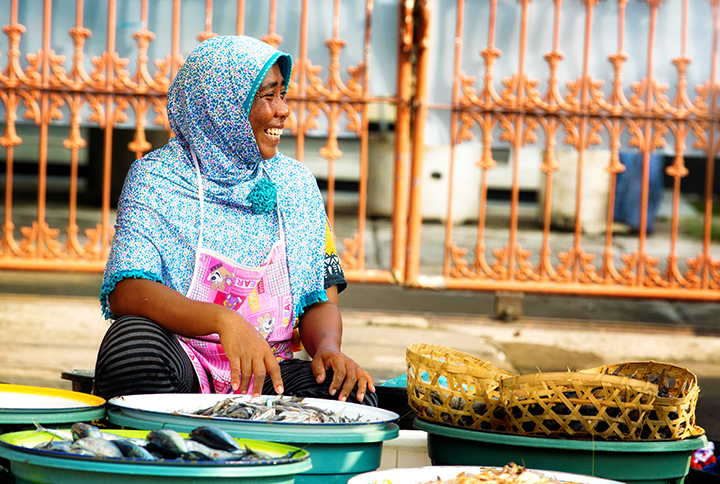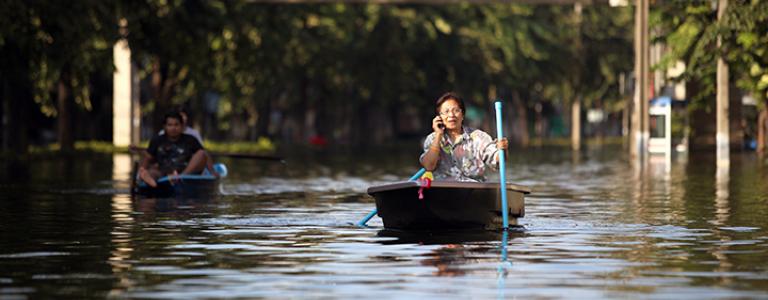Why Gender Matters in Climate Change Adaptation
Effective climate change adaptation recognizes that women, men and children experience impacts differently depending on where they live, how they sustain their livelihoods, and the roles they play in their families and communities.
Climate change is the most critical challenge facing humanity today.
Experts are raising the alarm about this crisis with increasing anxiety. Clearly, urgent action is needed to reduce greenhouse gas emissions in order to limit the global temperature rise over the coming years.

But what about the people who are experiencing the impacts of climate change now, today? And those who will experience worsening impacts for the foreseeable future?
For the first time, in 2015, the Paris Agreement under the United Nations Framework Convention on Climate Change established a global goal for adaptation to climate change. This was a recognition that we are committed to a certain amount of climate change and that investment in adaptation is both necessary and increasingly urgent.
Climate change is inherently a justice issue—those who have contributed least to its causes will suffer most from its effects. At the global level, such as in the Paris Agreement, this is already recognized.
Infographic | Addressing Gender Equality in Climate Change Adaptation
This agreement, ratified by 185 countries, makes the links between climate change and human rights, poverty eradication and sustainable development. It also acknowledges the importance of gender equality and women’s empowerment, and calls for climate action to be gender-responsive.
So how do these commitments play out in practice? With limited resources available for adaptation, particularly in poorer countries, how can we ensure that investments reach the most vulnerable women, men, girls and boys? How can we ensure that efforts to respond to this unprecedented challenge eliminate, rather than exacerbate, inequalities?

At the International Institute for Sustainable Development, we are increasingly focused on the gender implications of sustainable development policies and investments. Among other projects, we work with governments to promote planning for climate change adaptation that is gender-responsive. This comes down to three things:
Who matters?
Who decides?
Who benefits?
The right answer to all of these questions is, of course, everyone. Everyone matters when it comes to managing the impacts of climate change, particularly those who are least able to adapt. Everyone should have a say in how climate action occurs, and everyone should benefit from investments in adaptation in an equitable manner.
But when we are thinking about who matters, we need to recognize that people experience the impacts of climate change in different ways. A livestock herder in the Ethiopian lowlands has a much different experience of climate change than a civil servant in Addis Ababa. A woman in a poor rural household has a different experience of climate change than her husband.
People have different adaptation needs, depending on where they live, how they sustain their livelihoods, and the roles they play in their families and communities. There are socially determined differences too—in opportunities, responsibilities and decision-making power—and all of these influence how vulnerable people are to climate change.
Without understanding these dynamics—which are often influenced by gender—there is a risk that the people with the greatest need for adaptation will be left out.

Effective adaptation considers the differing needs of women and men, as well as marginalized groups, to ensure that investments are targeted where they are needed most.
The reality in many countries is that women are under-represented in decision-making in areas relevant to climate change adaptation. For example, in many African countries, the number of women in senior positions in the government is concerningly small. And at the household level, decision-making power still often rests with men.
If women are not involved in decision-making, how likely is it that their interests will be represented?
Effective climate change adaptation brings everyone to the table, recognizing the value of their knowledge and their potential as agents of change. The process of adaptation planning is designed to make it possible to invest in concrete actions that reduce vulnerability to climate change.
However, there is a risk that adaptation investments actually reinforce existing wealth and power structures, rather than benefiting the most vulnerable women and men. Adaptation is effective when it is equitable, providing opportunities and benefits for all people.
The urgency of adapting to climate change has never been clearer. We have an opportunity, through global commitments like the Paris Agreement, to rapidly scale up action in this area. For this to be effective, we need to start from the premise that everyone matters—rich or poor, farmer or civil servant, woman or man.
We need to bring diverse voices, including those that are typically excluded, into decision making to identify the best solutions for adapting to climate change. And we need to ensure that investments in adaptation provide equitable benefits for people of all genders and social groups. This is the only way we can build families, communities and societies that are resilient to the impacts of climate change.
You might also be interested in
Toolkit for Monitoring, Evaluation, and Learning for National Adaptation Plan Processes
This toolkit provides practical guidance for the development and continuous improvement of MEL systems for national adaptation plan processes to government teams and practitioners working on adaptation.
Envisioning Resilience: Women's Voices on Climate Change in Ghana and Kenya
As countries advance their National Adaptation Plan (NAP) processes, the need for meaningful participation by people on the frontlines of climate change becomes increasingly clear.
Mainstreaming gender in climate change adaptation in Côte d'Ivoire and Ghana
But in gender-responsive adaptation planning, understanding the impacts is only half the battle. It also requires forming gender-equitable decision-making processes around adaptation, including at the national level. Since 2018, IISD has been helping to drive steady progress in integrating gender considerations in NAP processes. Among the NAPs submitted to the United Nations Framework Convention on Climate Change (UNFCCC) as of March 2023, 98% mention gender and approximately half recognize women as agents of change in climate change adaptation.
Learning From Gender-Responsive National Adaptation Plan Processes: Insights from countries to inform the review of the UNFCCC Gender Action Plan
Based on the priority actions of 10 African and Caribbean countries for integrating gender equality in their National Adaptation Plan (NAP) processes, we identified recommendations for effectively advancing the Gender Action Plan (GAP) under the United Nations Framework Convention on Climate Change (UNFCCC).
